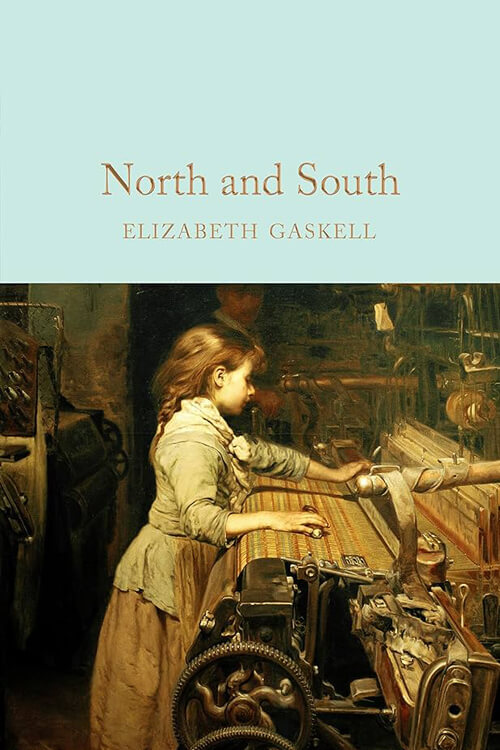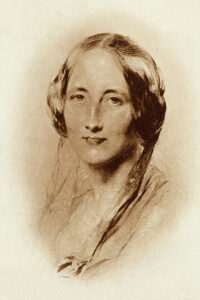
North and South
Margaret went into the old nursery at the very top of the house, where Newton was busy getting up some required laces for the wedding. While Newton went (not without a muttered grumbling) to undo the shawls, which had already been exhibited four or five times that day, Margaret looked round upon the nursery, the first room in that house with which she had become familiar nine years ago, when she was brought, all untamed from the forest, to share the home, the play, and the lessons of her cousin Edith.
She remembered the dark, dim look of the London nursery, presided over by an austere and ceremonious nurse who was particular about clean hands and torn dresses. She recollected the first tea up there—separate from her father and aunt, who were dining below an infinite depth of stairs, for unless she were up in the sky (the child thought), they must be deep down in the earth’s bowels. At home—before she came to live in Harley Street—her mother’s dressing room had been her nursery, and, as they kept early hours in the country parsonage, Margaret had always had her meals with her father and mother.
Oh! Well did the tall, stately girl of eighteen remember the tears shed with such wild passion of grief by the little girl of nine as she hid her face under the bed-clothes that first night and how she was bidden not to cry by the nurse because it would disturb Miss Edith; and how she had cried as bitterly, but more quietly, till her newly-seen, grand, pretty aunt had come softly upstairs with Mr. Hale to show him his little sleeping daughter.
Then little Margaret had hushed her sobs and tried to lie quiet as if asleep for fear of making her father unhappy by her grief, which she dared not express before her aunt and which she instead thought it was wrong to feel at all after the long hoping, and planning, and contriving they had gone through at home, before her wardrobe could be arranged to suit her grander circumstances, and before papa could leave his parish to come up to London, even for a few days.
Read or download Book
Elizabeth Gaskell
Elizabeth Cleghorn Gaskell (née Stevenson; 29 September 1810 – 12 November 1865), often referred to as Mrs Gaskell, was an English novelist, biographer, and short story writer. Her novels offer a detailed portrait of the lives of many strata of Victorian society, including the very poor. Her first novel, Mary Barton, was published in 1848. Gaskell’s The Life of Charlotte Brontë, published in 1857, was the first biography of Charlotte Brontë. In this biography, she wrote only of the moral, sophisticated things in Brontë’s life; the rest she omitted, deciding certain, more salacious aspects were better kept hidden. Among Gaskell’s best-known novels are Cranford (1851–1853), North and South (1854–1855), and Wives and Daughters (1864–1866), all of which were adapted for television by the BBC.
Early life
Gaskell was born Elizabeth Cleghorn Stevenson on 29 September 1810 in Lindsey Row, Chelsea, London, now 93 Cheyne Walk. The doctor who delivered her was Anthony Todd Thomson, and Thomson’s sister Catherine later became Gaskell’s stepmother. She was the youngest of eight children; only she and her brother John survived infancy. Her father, William Stevenson, a Unitarian from Berwick-upon-Tweed, was minister at Failsworth, Lancashire, but resigned his orders on conscientious grounds. He moved to London in 1806 to go to India after being appointed private secretary to the Earl of Lauderdale, who was to become Governor General of India. However, that position did not materialise, and Stevenson was nominated Keeper of the Treasury Records.
His wife, Elizabeth Holland, came from a family established in Lancashire and Cheshire and connected with prominent Unitarian families, including the Wedgwoods, the Martineaus, the Turners and the Darwins. When she died 13 months after giving birth to Gaskell, her husband sent Gaskell to live with her mother’s sister, Hannah Lumb, in Knutsford, Cheshire.
Her father remarried Catherine Thomson in 1814. They had a son, William, in 1815 and a daughter, Catherine, in 1816. Although Elizabeth spent several years without seeing her father, to whom she was devoted, her older brother John often visited her in Knutsford. John was destined for the Royal Navy from an early age, like his grandfathers and uncles, but he did not obtain preferment for the Service and had to join the Merchant Navy with the East India Company’s fleet. John went missing in 1827 during an expedition to India.
Character and influences
Elizabeth was a beautiful young woman who was well-groomed, tidily dressed, kind, gentle, and considerate of others. Her temperament was calm and collected, joyous and innocent. She revelled in the simplicity of rural life. Much of Elizabeth’s childhood was spent in Cheshire, where she lived with her aunt Hannah Lumb in Knutsford, the town she immortalized as Cranford. They lived in a large red-brick house called The Heath (now Heathwaite).
From 1821 to 1826, she attended a school in Warwickshire run by the Misses Byerley, first at Barford and from 1824 at Avonbank outside Stratford-on-Avon, where she received the traditional education in arts, the classics, decorum and decency given to young ladies from relatively wealthy families at the time. Her aunts gave her the classics to read, and her father encouraged her in her studies and writing. Her brother John sent her modern books describing his life at sea and experiences abroad.
After leaving school at 16, Elizabeth travelled to London with her Holland cousins. She also spent some time in Newcastle upon Tyne (with the Rev William Turner’s family) and then made the journey to Edinburgh. Her stepmother’s brother was the miniature artist William John Thomson, who 1832 painted a portrait of Elizabeth Gaskell in Manchester (see top right). At the same time, David Dunbar sculpted a bust.
Married life and writing career
On 30 August 1832, Elizabeth married Unitarian minister William Gaskell in Knutsford. They spent their honeymoon in North Wales, staying with her uncle, Samuel Holland, at Plas-yn-Penrhyn near Porthmadog. The Gaskells then settled in Manchester, where William was the minister at Cross Street Unitarian Chapel and the longest-serving Chair of the Portico Library. Manchester’s industrial surroundings and books borrowed from the library influenced Elizabeth’s writing in the industrial genre. Their first daughter was stillborn in 1833. Their other children were Marianne (1834), Margaret Emily, known as Meta (1837), Florence Elizabeth (1842), and Julia Bradford (1846). Marianne and Meta boarded at the private school conducted by Rachel Martineau, Harriet’s sister and a close friend of Elizabeth’s. Florence married Charles Crompton, a barrister and Liberal politician, in 1863.
In March 1835, Gaskell began a diary documenting the development of her daughter Marianne: she explored parenthood, the values she placed on her role as a mother, her faith, and, later, relations between Marianne and her sister, Meta. In 1836, she co-authored a cycle of poems, Sketches among the Poor, with her husband, published in Blackwood’s Magazine in January 1837. In 1840, William Howitt published Visits to Remarkable Places, containing a contribution entitled Clopton Hall by “A Lady”, the first work written and published solely by her. In April 1840, Howitt published The Rural Life of England, which included a second work titled Notes on Cheshire Customs.
In July 1841, the Gaskells travelled to Belgium and Germany. German literature came to have a strong influence on her short stories, the first of which she published in 1847 as Libbie Marsh’s Three Eras in Howitt’s Journal under the pseudonym “Cotton Mather Mills”. But other influences, including Adam Smith’s Social Politics, enabled a much more comprehensive understanding of the cultural milieu in which her works were set. Her second story, printed under the pseudonym, was The Sexton’s Hero. She made her last use of it in 1848 with the publication of her story Christmas Storms and Sunshine.
For some 20 years, beginning in 1843, the Gaskells took holidays at Silverdale on Morecambe Bay and, in particular, stayed at Lindeth Tower. Daughters Meta and Julia later built a house, “The Shieling”, in Silverdale.
A son, William (1844–45), died in infancy, and this tragedy was the catalyst for Gaskell’s first novel, Mary Barton. It was ready for publication in October 1848, shortly before they moved south. It was an enormous success, selling thousands of copies. Ritchie called it a “great and remarkable sensation.” Thomas Carlyle and Maria Edgeworth praised it. She brought the teeming slums of manufacturing in Manchester alive to readers as yet unacquainted with crowded, narrow alleyways. Her obvious depth of feeling was evident, while her turn of phrase and description was described as the greatest since Jane Austen.
In 1850, the Gaskells moved to a villa at 84 Plymouth Grove. She took her cow with her. For exercise, she would happily walk three miles to help another person in distress. Elizabeth wrote her remaining literary works in Manchester while her husband held welfare committees and tutored the poor in his studies. The Gaskells’ social circle included writers, journalists, religious dissenters, and social reformers such as William and Mary Howitt and Harriet Martineau. Poets, patrons of literature, and writers such as Lord Houghton, Charles Dickens, and John Ruskin visited Plymouth Grove, and the American writers Harriet Beecher Stowe and Charles Eliot Norton did, too. At the same time, the conductor Charles Hallé, who lived close by, taught piano to one of their daughters. Elizabeth’s friend Charlotte Brontë stayed there three times and, on one occasion, hid behind the drawing room curtains as she was too shy to meet the Gaskells’ other visitors.






